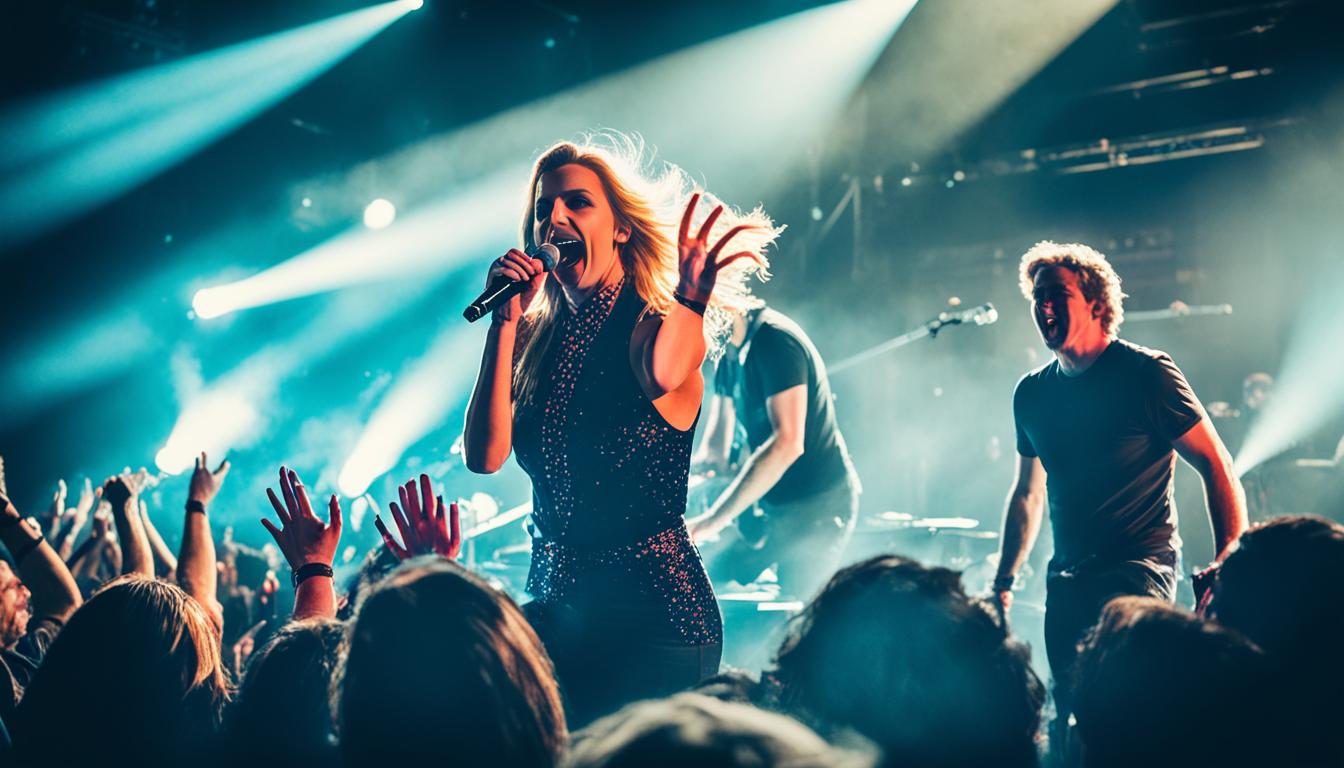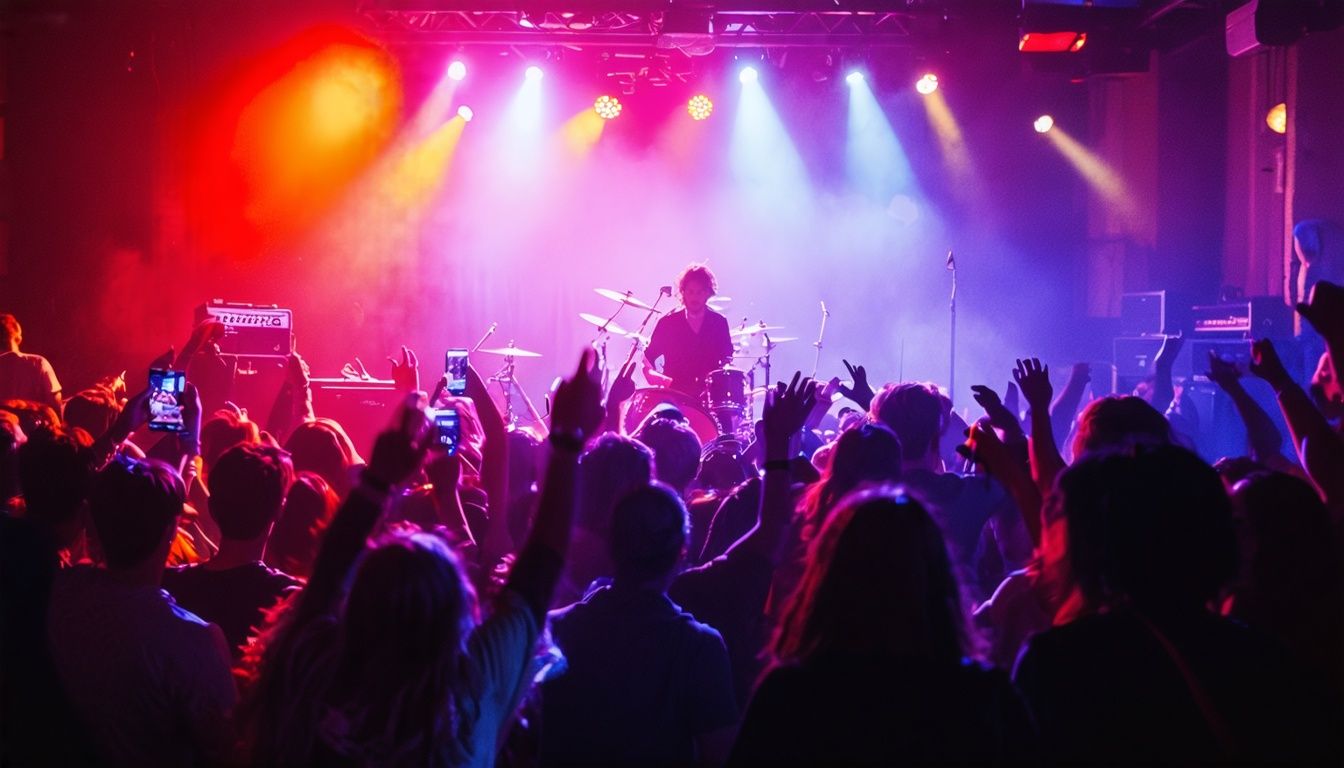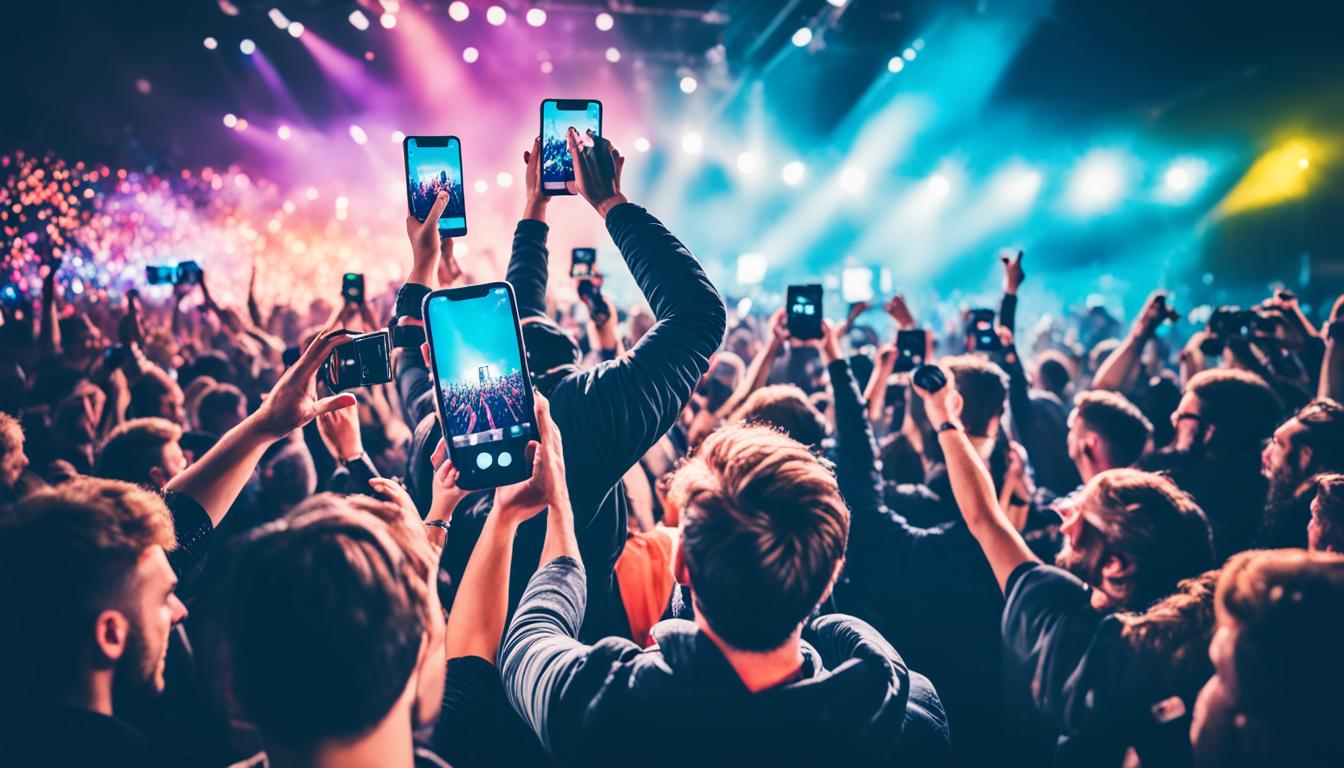We are deeply engaged in the art of creating memorable images. The choice between using flash or not in concert photography is a big deal. Most live shows don’t allow flash, pushing us to get creative. We see these limits as chances to get better at taking concert photos. We use skill and creativity to capture these short-lived moments, keeping the real spirit of live music alive.
Key Takeaways
- Understanding the constraints of flash photography in live music settings enhances professionalism.
- Adapting our camera settings for no flash situations is key to capturing sharp concert photos.
- Mastering the balance between ambient light and camera capabilities underpins successful concert photography.
- Shooting in RAW can be a saving grace in managing the challenging lighting contrasts at concerts.
- Embracing innovative concert photography techniques can translate to more genuine and impactful imagery.
Understanding the Dynamics of Concert Lighting
For photographers, diving into the concert scene starts with knowing about concert lighting. It’s key to showing off a performance. Mastering low light photography means managing silhouettes, spotlights, and shadows well. Let’s explore the tough spots and silent rules that shape concert photography’s world.
Challenges of Low Light Environments
Tackling low light photos is tough. It’s where brave photographers go to test their skills. Dim stages and sudden light changes challenge our creativity and push our cameras to their limits. We juggle ISO, aperture, and shutter speed to perfectly capture live music’s raw emotion and energy.
The Impact of Venue Rules on Photography
Inside a concert hall, it’s not just about getting great shots. It’s also about following the venue’s rules. Many places have strict no-flash rules to keep the show’s integrity. These rules make us work with the natural light and understand concert lighting better. That way, we’re ready for that perfect lighting moment.
Respecting Performers and Audience with Lighting Choices
Our photo choices reflect our respect for artists and the crowd. It’s important to stay unnoticed and not disturb. Embracing the soft stage light feels natural. It’s about balancing being there without being seen, like hitting the right note in a song.
| Camera Setting | Low Light Advantage | Consideration |
|---|---|---|
| Aperture | Larger apertures (lower f-number) allow more light | Depth of field can become shallow; subject isolation |
| ISO | Higher ISO compensates for low light | Risk of digital noise; balance according to camera’s capability |
| Shutter Speed | Slower speeds may capture more light | Risk of motion blur; use with consideration of movement |
Photography Gear for Live Music Success
As lovers of concert photography, we know it takes more than a camera to capture great music shots. We must discuss the right photography gear for live music. Choosing the right equipment is key in the low-light, lively concert scenes. It makes the difference between dull photos and ones that capture the concert’s spirit.
Finding the best camera settings for concerts is essential. Start with a lens that lets in a lot of light, like one with an aperture of f/1.4 to f/2.8. This bright lens brings enough light to your camera sensor. It helps fight the low-light challenge. Combine this with a camera that handles high ISOs well, and you’re set for clear, noise-free pictures.
Using RAW format is crucial when shooting concerts. It captures more detail in varied lighting than JPEGs. This gives you more control in editing, letting you perfect the exposure, colors, and details.
| Lens Type | Aperture | Best Use |
|---|---|---|
| Prime Lens | f/1.4 – f/2 | Ideal for sharp, fixed focal length shots in very low light |
| Zoom Lens | f/2.8 – f/4 | Versatile for varying compositions; maintains reasonable light intake |
| Wide-Angle Lens | f/2.8 and wider | Suitable for capturing the vastness of the venue and audience |
Concert lighting changes quickly, and we need to adjust settings fast. High shutter speed catches the energetic moves of the performers. A good ISO keeps the pictures sharp and well-lit.
Every concert is different, with its own lighting and challenges. Being well-prepared with the right photography gear for live music and best camera settings for concerts is crucial. Let’s get ready, immerse in the music, and capture its essence with every click.
Flash vs. No Flash in Concert Photography
We dive into the exciting world of live performance photography, faced with a big choice. Should we use flash or not? This decision isn’t just about what we prefer. It shapes how we approach our photography.
Flash Photography: When Is It Appropriate?
Sometimes, flash can light up scenes that would be too dark otherwise. If the performers and venue say it’s okay, using flash carefully can be amazing. But, remember, this doesn’t happen often. We need approval and the right situation to use flash properly.

Navigating the No Flash Policy: Adapting Techniques
Many venues and artists say no to flash. They want to keep the show real for everyone. It’s our job to work with what we have. Knowing our camera settings and the lighting lets us tell the story of the concert without flash.
Debating Professionalism: The Use of Flash in Concerts
In the world of concert photography, using flash can cause disagreements. Some say it ruins the mood, while others think it adds something special. We believe in being careful and respectful. This way, we keep the magic of live shows intact as we capture them.
| Flash Photography | No Flash Photography |
|---|---|
| Potentially disrupts performances | Preserves the natural concert experience |
| Requires permission from venues and artists | Welcomed as the standard professional practice |
| Creates dynamic lighting when used properly | Challenges the photographer to innovate with ambient light |
| Can enhance details in poorly lit situations | Demands higher ISO, wider apertures, and steadier hands |
In the debate of flash versus no flash, our skills and flexibility are key. Whether we add light or use what’s there, capturing the emotion and energy is what matters. Our goal is to let people experience the magic of live shows again and again.
Best Camera Settings for Capturing Live Performances
In the electrifying world of concert photography, understanding the best camera settings for concerts is key. Like a musician learns their scales, we must know our camera’s settings. As we move through dimly lit venues and bright stage lights, we aim our lenses in tune with the music. We use special concert photography techniques to make each moment last forever.
We often choose the RAW format on our cameras. This setting helps us capture the whole vibe of the performance. Later, we can adjust the contrast and colors to reflect the true ambiance of the venue.

When the bass drops and lights flash, our cameras are ready. We adjust ISO to avoid shadows and keep our images clear. We also manually adjust white balance because automatic settings can miss the mark under stage lighting.
Wondering about specific settings? Here’s a simple guide. It links best camera settings for concerts with key concert photography techniques.
| Setting | Role in Concert Photography | Recommended Value |
|---|---|---|
| RAW Format | Maximizes post-production flexibility; retains high image quality. | Always enable |
| ISO Sensitivity | Adjusts for low light while minimizing noise. | 800 – 3200 (adjust as needed) |
| Spot Metering | Targets exposure for a performer’s face or specific lighting condition. | Use selectively for key subjects |
| White Balance | Ensures colors match the scene’s warmth or coolness. | Adjust manually for varied lighting |
| Aperture | Controls depth of field and the amount of light entering the lens. | f/1.4 – f/2.8 (larger apertures for low light) |
| Shutter Speed | Freezes motion without blurring; vital for capturing dynamic performances. | 1/250 sec or faster (may need to be faster for intense action) |
In our picture-taking symphony, these settings are our notes. They help us keep the beat and find harmony. With these settings, we don’t just see the energy of live shows—we feel it. So, tune your gear, use these settings, and capture concerts like a pro. The stage is yours—make every shot count.
Conclusion
We’ve learned a lot about concert photography. It’s more than just taking pictures. We need to be strategic and understand the setting. Knowing how to work with concert lighting is key. This helps us decide when to use flash without ruining the live show’s vibe.
With these concert photography tips, we’re more equipped to handle live events. We must be patient and adaptable, using natural light to our advantage. It’s not just about the gear in photography gear for live music. It’s about choosing the right tools that match our artistic goals.
Through our discussions, we’ve gained valuable insights into concert photography. These lessons prepare us to excel in this exciting field. By combining our skills with respect for live performances, we can tell powerful stories through our photos. Let’s capture the essence of music and make visuals that leave a lasting impact.
FAQ
Should I use flash for concert photography?
It’s best not to use flash when taking photos at concerts. Most venues don’t allow it. Flash can disrupt the show and upset everyone there. Try to work with the low lighting, using the right camera settings and equipment.
What are the challenges of low light environments in concert photography?
In low light, you need to adjust your camera’s ISO higher. You should use lenses with big apertures. Shooting in RAW format helps with editing later. The goal is to get clear, bright photos without too much digital noise.
How do I respect the rules of the concert venue regarding flash photography?
Always check the venue’s photo policies first. If they say no flash, then don’t use it. You’ll have to depend on camera skills for low light. Following these rules keeps a good relationship with the venue and ensures quality work.
How can I respect performers and audience with my lighting choices?
Avoid flash to keep the show enjoyable for everyone. Use the stage lights well. Choose fast lenses and settings that make the most of the existing light. This way, you don’t disturb the performance or the audience.
What gear is essential for successful live music photography?
You’ll need a camera good at handling high ISO levels with minimal noise. Also, use lenses that open wide (f/2.8 or more) and have image stabilization. Cameras that are great with high ISOs and can shoot RAW are best.
When might it be appropriate to use flash in concert photography?
Only use flash if the venue and artists say it’s okay. An off-camera flash with a diffuser is less disruptive. This kind of flash adds light gently, without ruining the mood or show.
How can I adapt my photography techniques to a no flash policy?
Learn to love the ambient light. Adjust your camera for dark settings and shoot RAW for better editing later. Pick lenses that let in a lot of light. You may need to increase your ISO and use slower shutter speeds too.
Is using flash in concerts unprofessional?
There’s a big debate about using flash in concert photography. Usually, it’s seen as unprofessional and bothersome. Good concert photos capture the real vibe of the event without bothering anyone.
What are the best camera settings for capturing live performances?
For live shows, set your camera for quick shutter speeds to stop motion. Pick a wide aperture and a higher ISO setting. Manual focus gives you control. Use burst mode to catch the most exciting moments.



